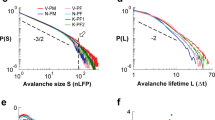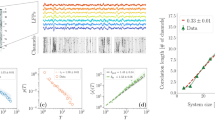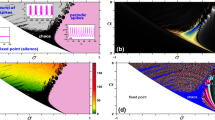Abstract
Recent experiments have detected a novel form of spontaneous neuronal activity both in vitro and in vivo: neuronal avalanches. The statistical properties of this activity are typical of critical phenomena, with power laws characterizing the distributions of avalanche size and duration. A critical behaviour for the spontaneous brain activity has important consequences on stimulated activity and learning. Very interestingly, these statistical properties can be altered in significant ways in epilepsy and by pharmacological manipulations. In particular, there can be an increase in the number of large events anticipated by the power law, referred to herein as dragon-king avalanches. This behaviour, as verified by numerical models, can originate from a number of different mechanisms. For instance, it is observed experimentally that the emergence of a critical behaviour depends on the subtle balance between excitatory and inhibitory mechanisms acting in the system. Perturbing this balance, by increasing either synaptic excitation or the incidence of depolarized neuronal up-states causes frequent dragon-king avalanches. Conversely, an unbalanced GABAergic inhibition or long periods of low activity in the network give rise to sub-critical behaviour. Moreover, the existence of power laws, common to other stochastic processes, like earthquakes or solar flares, suggests that correlations are relevant in these phenomena. The dragon-king avalanches may then also be the expression of pathological correlations leading to frequent avalanches encompassing all neurons. We will review the statistics of neuronal avalanches in experimental systems. We then present numerical simulations of a neuronal network model introducing within the self-organized criticality framework ingredients from the physiology of real neurons, as the refractory period, synaptic plasticity and inhibitory synapses. The avalanche critical behaviour and the role of dragon-king avalanches will be discussed in relation to different drives, neuronal states and microscopic mechanisms of charge storage and release in neuronal networks.
Similar content being viewed by others
References
HE Stanley, Introduction to Phase Transitions and Critical Phenomena (Oxford Univ. Press, New York, 1971)
P. Bak, How nature works. The Science of Self-organized Criticality (Springer, New York, 1996)
P. Bak, C. Tang, J. Geophys. Res. 94, 15635 (1989)
A. Sornette, D. Sornette, Europhys. Lett. 9, 197 (1989)
P. Bak, K. Sneppen, Phys. Rev. Lett. 71, 4083 (1993)
E.T. Lu, R.J. Hamilton, Astrophys. J. 380, L89 (1991)
P.A. Politzer, Phys. Rev. Lett. 84, 1192 (2000)
J. Faillettaz, F. Louchet, J.R. Grasso, Phys. Rev. Lett. 93, 208001 (2004)
O. Peters, C. Hertlein, K. Christensen, Phys. Rev. Lett. 88, 018701 (2002)
A. Gevins, et al., Trends Neurosci. 18, 429 (1995)
G. Buzsaki, A. Draguhn, Science 304, 1926 (2004)
J.M. Hausdorff, et al., Physica A. 302, 138 (2001)
S.B. Lowen, S.S. Cash, M. Poo, M.C. Teich, J. Neuroscience 17, 5666 (1997)
D.R. Chialvo, G.A. Cecchi, M.O. Magnasco, Phys. Rev. E 61, 5654 (2000)
W.L. Shew, H. Yang, T. Petermann, R. Roy, D. Plenz, J. Neurosci. 29, 155595 (2009)
C.M. Lewis, A. Baldassarre, G. Committeri, G.L. Romani, M. Corbetta, Proc. Natl. Acad. Sci. USA 106, 17558 (2009)
L. de Arcangelis, H.J. Herrmann, Proc. Natl. Acad. Sci. 107, 3977 (2010)
D. Purves, G.J. Augustine, D. Fitzpatrick, W.C. Hall, Neuroscience (Sinauer, Sunderland, 2004)
D.O. Hebb, The Organization of Behaviour (John Wiley, New York, 1949)
O. Shefi, I. Golding, R. Segev, E. Ben-Jacob, A. Ayali, Phys. Rev. E. 66, 021905 (2002)
D.J. Watts, S.H. Strogatz, Nature 393, 440 (1998)
V.M. Eguiluz, D.R. Chialvo, G.A. Cecchi, M. Baliki, A.V. Apkarian, Phys. Rev. Lett. 94, 0181021 (2005)
G.A. Arieli, A. Sterkin, A. Aertsen, Science 273, 1868 (1996)
R. Azouz, C.M. Gray, J. Neurosci. 19, 2209 (1999)
C.F. Stevens, T. Tsujimoto, Proc. Natl. Acad. Sci. 92, 846 (1995)
K.J. Staley, et al., Nat. Naurosci. 1, 201 (1998)
E. Maeda, H.P. Robinson, A. Kawana, J. Neurosci. 15, 6834 (1995)
R. Segev, et al., Phys. Rev. Lett. 88, 118102 (2002)
J.M. Beggs, D. Plenz, J. Neurosci. 23, 11167 (2003)
J.M. Beggs, D. Plenz, J. Neurosci. 24, 5216 (2004)
I. Osorio, M.G. Frei, D. Sornette, J. Milton, Y.C. Lai, Phys. Rev. E 82, 021919 (2010)
E.D. Gireesh, D. Plenz, Proc. Natl. Acad. Sci. 105, 7576 (2008)
T. Petermann, et al., Proc. Natl. Acad. Sci. 106, 15921 (2009)
A. Mazzoni, et al., PLoS ONE 5, e439 (2007)
V. Pasquale, et al., Neuroscience 153, 1354 (2008)
W.L. Shew, et al., J. Neurosci. 29, 15595 (2009)
S. Zapperi, K.B. Lauritsen, H.E. Stanley, Phys. Rev. Lett. 75, 4071 (1995)
S. Pajevic, D. Plenz, PLoS Computational Biology 5, e1000271 (2009)
L. de Arcangelis, C. Perrone-Capano, H.J. Herrmann, Phys. Rev. Lett. 96, 028107 (2006)
G.L. Pellegrini, L. de Arcangelis, H.J. Herrmann, C. Perrone-Capano, Phys. Rev. E 76, 016107 (2007)
A. Levina, J.M. Herrmann, T. Geisel, Nat. Phys. 3, 857 (2007)
J.N. Teramae, T. Fukai, J. Comput. Neurosci. 22, 301 (2007)
E. Novikov, A. Novikov, D. Shannahoff-Khalsa, B. Schwartz, J. Wright, Phys. Rev. E 56, R2387 (1997)
B. Roerig, B. Chen, Cerebral Cortex 12, 187 (2002)
S.J. Cooper, Neurosci. Biobehav. Rev. 28, 851 (2005)
N.S. Desai, J. Physiol. Paris 97, 391 (2003)
T.D. Albraight, et al., Neuron, Rev. Suppl. 59 (2000)
O. Paulsen, T.J. Sejnowski, Curr. Opin. Neurobiol. 10, 172 (2000)
K.H. Braunewell, D. Manahan-Vaughan, Rev. Neurosci. 12, 121 (2001)
G.Q. Bi, M.M. Poo, Annu. Rev. Neurosci. 24, 139 (2001)
M. Pica Ciamarra, E. Lippiello, C. Godano, L. de Arcangelis, EPL (to appear)
M. Pica Ciamarra, E. Lippiello, C. Godano, L. de Arcangelis, Phys. Rev. Lett. 104, 238001 (2010)
Author information
Authors and Affiliations
Rights and permissions
About this article
Cite this article
de Arcangelis, L. Are dragon-king neuronal avalanches dungeons for self-organized brain activity?. Eur. Phys. J. Spec. Top. 205, 243–257 (2012). https://doi.org/10.1140/epjst/e2012-01574-6
Received:
Revised:
Published:
Issue Date:
DOI: https://doi.org/10.1140/epjst/e2012-01574-6




